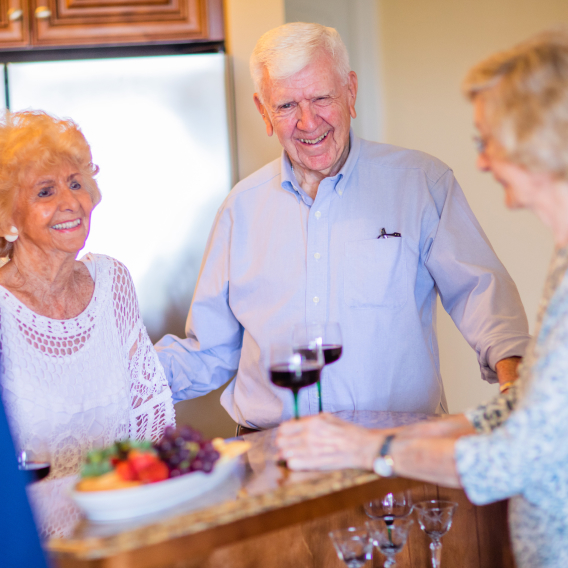6 Tips to Finding the Best Memory Care Community
Listen to this article

Memory care facilities focus on providing the level of support and care residents need to thrive and live more fulfilling lives. These communities are highly specialized to support older adults who have been diagnosed with Alzheimer’s disease or dementia. However, not all memory care communities are alike, and some communities are better than others, so it’s important to do thorough research to ensure you’ve chosen the right community for your loved one.
Tips for Finding Memory Care Communities
Memory care facilities provide a safe and structured environment for people who have been diagnosed with Alzheimer’s disease or dementia. Staff members provide residents with the amount of attention and support they need to ensure they’re taking care of their daily needs and eating healthily.
The best communities ensure residents live enriched lives in an environment based on individualized, person-centered care. Here are some expert tips to help you find the right community for your loved one.
1. Start Your List
Begin by looking for memory care facilities near you. In addition to performing a Google search, it can help to ask your loved one’s doctor if they have recommendations. Aim to have several communities on your list. You’ll be able to narrow down your options through further research and exploring the communities in person.
2. Read Reviews
While you’re doing your initial research, read the reviews for the communities that you’re interested in. Checking for reviews from staff members on job boards can also be beneficial and help you get an idea about what life is like in the community. Social media can also tell you a lot about what’s going on in the community, such as showcasing everyday life, activities, and helpful resources.
3. Look at Community Websites
Many communities will have a wealth of information available on their websites, including floor plans, photos, and the community’s purpose. Take time to thoroughly review the website, including noting what amenities the community offers and the community’s purpose and mission. Downloadable resources, such as brochures, can be helpful to print out so you can jot notes directly onto the brochure, organize your options, and avoid confusing features of different communities.
4. Prepare Questions
As your list of communities to tour begins to take shape, come up with questions to ask during your tours that will help you determine the ideal community for your loved one. Questions about safety, activities, care plans, and reassessments are some of the important points you’ll want to cover.
5. Tour Communities
Online research is important, but once you have a list of communities, it’s essential to see them in person. Preferably, you should visit a few times at different times of the day. You don’t need to see every community on your list in person (your research may eliminate some of the communities on your initial list), but you should aim to tour at least three memory care facilities. This will help you see the community in action, observe how staff members interact with residents, and ask questions.
6. Be Aware of Red Flags During Tours
While you’re taking note of all the good things in the community, make sure you’re paying attention to potential problems. These may include:
- Unclean areas
- Limited socialization opportunities
- Staff members who won’t or can’t answer questions
- Residents waiting a long time for assistance
- A lot of infections within the community
- Poor food quality
- Limited food options
What to Look for in a Memory Care Community
There are numerous options when it comes to memory care. This can feel empowering, but it can also be overwhelming. Here are some things to consider as you tour communities to find one that will help your loved one flourish.
Person-Centered Care
People aren’t all alike, so their care shouldn’t be the same as another’s—it should be personalized to their unique needs.
At Cedarhurst, we integrate information from each resident’s life story into our life enrichment program. This ensures that the activities we provide are currently of interest to your loved one and were of interest in their past. We also utilize these interests, dislikes, and personal details to help redirect residents during challenging moments.
Our guiding philosophy at Cedarhurst, Living TRUE℠, ensures we take an approach that’s personalized and tailored to each resident. A component of this is Movements and Mantras. This incorporates researched fitness and breathwork techniques, which help reduce stress, increase oxygen flow, improve focus, and enhance emotional regulation, all of which can be challenges for those living with Alzheimer’s disease or dementia.
Life Enrichment Opportunities
Intertwined in our Living TRUE℠ program are nature and art activities, which have therapeutic value related to mental and emotional well-being. Residents engage in a variety of activities in this program, such as cutting vegetables that they picked out of the garden, making a snack, enjoying a cup of coffee and chatting with other residents at a table, or playing a game with a life enrichment team.
At Cedarhurst, we understand that all activities aren’t for all people, so we focus on how we can provide meaningful and individualized moments based on the individual and what’s meaningful to them. Some residents seek engagement through painting, crafting, cooking, or playing games, but other people receive fulfillment through purpose-driven engagements.
For these residents, we utilize their life stories, life experiences, and past interests to create valuable and purposeful tasks. For example, if a resident worked in and enjoyed maintenance roles, they may be given a clipboard with tasks such as checking hinges on cabinets or ensuring light switches are working.
All Staff Members Follow Best Practices
All staff members should be aware of best practices for caring for those with Alzheimer’s disease or dementia. At Cedarhurst, our staff members are trained to follow best practices and provide person-centered care. Our managers and life enrichment teams are certified through the National Council of Certified Dementia Practitioners. Additionally, all staff members are trained in a program recognized by the Alzheimer’s Association for incorporating evidence-based dementia care practices to provide person-centered care.
Our housekeeping and dining staff members are trained in best practices for engaging with residents. For example, this includes learning if a resident is OK with housekeepers coming into their apartment and figuring out how to arrange food in a manner that promotes a resident’s independence and allows them to easily identify food items.
Questions to Ask a Memory Care Community
Finding memory care that’s a good fit for your loved one means asking the right questions in the right way. If possible, avoid yes/no questions so you can receive expanded answers and get the information you need.
Here are some insightful questions to help you get started:
- What are the associated costs?
- What types of activities are offered?
- What safety measures are taken within the community?
- What kind of training do staff members receive?
- How do you make the transition easier?
- What type of apartment is available?
- How will you determine my loved one’s care plan?
- What is the process for performing reassessments?
- What medical care is available?
- How do staff members interact with residents?
- Is there a waiting list?
What to Expect with Memory Care Pricing
Senior living pricing can seem confusing, and several factors go into the cost. Find out what to expect by downloading our resource, The Insider’s Guide to Understanding Memory Care Pricing.





.png?width=307&height=200&name=Blog%20%2333%201400%20x%20700%20(1).png)

.png?width=307&height=200&name=Blog%20%2332%201400%20x%20700%20(8).png)



